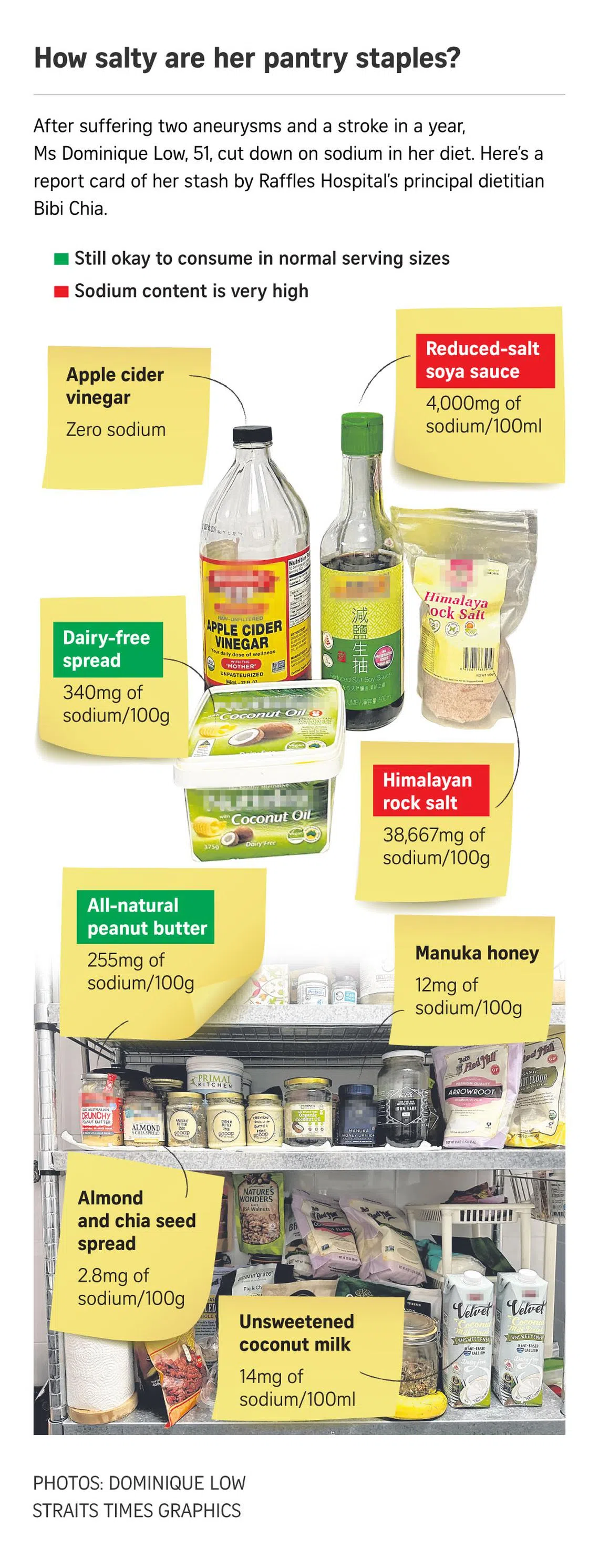Stroke survivor cuts down on sodium to boost health but hidden salt in foods poses challenge
Sign up now: Get ST's newsletters delivered to your inbox

Sodium is hidden in most processed and packaged foods like crackers and processed meats. Bread also contains high salt.
PHOTO ILLUSTRATION: PEXELS
Follow topic:
SINGAPORE – After suffering two brain aneurysms and a stroke in 2020, public relations specialist Dominique Low, 51, is mindful of what she eats.
“Since my recovery, I’ve tried to eat more healthily by reducing refined sugar and salt, eating less processed foods and choosing all natural spreads, like 100 per cent peanut butter without added sugars and salt,” she said.
Her husband Greg Rawson, who co-owns a public relations agency, cooks lunch and dinner “almost daily”.
“He keeps our meals healthy, like herbed chicken or herbed salmon with stir-fried leafy vegetables and sweet potatoes,” she added.
However, a peek in her pantry with the help of Raffles Hospital principal dietitian Bibi Chia showed that the sodium content of some of the choices Ms Low made were not as healthy as she thought they were.

In fact, the sodium content of a couple of condiments in her pantry is still very high. The reduced-salt soya sauce, for instance, has a sodium level of 4,000mg per 100ml and Himalayan rock salt is still salt, with a sodium level of 38,667mg per 100g,” Ms Chia said.
Sodium is a mineral that is essential for the normal functioning of the body, helping to transmit nerve impulses, keeps muscles working properly and maintains the body’s fluids in balance. But an excessive intake results in high blood pressure, which can lead to heart attacks and strokes.
Ms Chia said studies have shown that 75 per cent of the sodium people consume is hidden in the foods that they buy.
“It is hidden in most processed and packaged foods like sauces, crackers, processed meats, meat-free products and snacks. You may not even be aware, but some foods contain high salt, like bread, breakfast cereals and even soft drinks,” she added.

For example, a slice of bread contains 100mg to 172mg of sodium, making up between 5 per cent and 8.6 per cent of the daily limit recommended by the Health Promotion Board (HPB). A serving of instant noodles has 861mg of sodium.
Data from the 2022 National Population Health Survey, that tracked the health and risk factors of residents aged 18 to 74 between July 2021 and June 2022, found that nine in 10 Singaporeans are consuming too much salt,
Salt intake climbed from 3,480mg in 2019 to 3,620mg in 2022, far beyond the recommended daily allowance of 2,000mg or one teaspoonful.
This latest data also showed that more than a third of people now suffer from high blood pressure, raising the danger of heart disease and stroke. According to the Stroke Registry Annual Report of 2020, the number of stroke episodes increased from 5,890 in 2010 to 8,846 in 2020.
“As of now, we are not winning the battle on lifestyles,” Health Minister Ong Ye Kung said last Wednesday at the launch of a five-year government-funded cardiovascular research project.
The project aims to gain a deeper understanding of the population’s metabolism, heart and liver health, and lifestyle behaviour to prevent heart diseases including heart attack and stroke.
Singapore is studying possible regulatory measures to reduce sodium content in food as it steps up efforts to get the food industry and the population to shift to healthier options, said Mr Ong.
Mindful of the health risks, Mr Nurkhairi Abdul Hadi, 48, also consciously cuts down on his salt intake. Previously working for an offshore salvage company before retiring early, he was diagnosed with high blood pressure in 2015 and has been on medication since.
“I was often based offshore and overseas and on the vessel, I would often eat processed food and lots of barbecued meats. We were also ‘pampered’ with cheese snacks and potato chips. That was when all my diet went haywire,” he said.
Now, he eats out daily but avoids fast food and chooses fresh produce, fish and vegetables.
“I reduce the frequency I eat canned and processed food. I also ask for less gravy and make sure I have more vegetables and salad in all my meals,” he added.
Unfortunately, cooks and hawkers in Singapore have been adding more salt and sauces to their dishes over the years.
According to a food composition analysis carried out by the HPB, a serving of mee goreng, which used to contain 1,946mg of sodium in 2010 to 2012, now has 3,854mg – a 98 per cent increase.
Other sodium-laden dishes that have become even saltier over the years include steamed chicken rice (1,565mg of sodium in 2023 compared with 949mg from 2010 to 2012) and seafood hor fun, which has 37 per cent more sodium today (2,575mg, up from 1,885mg between 2010 and 2012). Just a plate would bust a person’s daily recommended sodium intake of 2,000mg.
HPB will be rolling out a campaign to encourage industry and food and beverage operators to pledge to reduce sodium content in their dishes to the levels in 2010.
This comes as an HPB market study showed that between 2010 and 2023, the sodium content of dishes went up by an average of 20 per cent.
Calling on diners to request less salty dishes, Mr Ong said last Wednesday that South-east Asia has been the land of spices.
“We use a great variety of spices and ingredients in our food, and we use a wide range of meats, seafood, vegetables and fruits in our local dishes. All of them add natural flavours to our food,” he said.
Agreeing, Ms Chia said that while it is hard not to acquire a taste for salt when it is hidden in many foods, retraining the taste buds to get used to less salt is like learning a new skill.
“It takes several weeks or even a few months for your taste buds to fully adapt to the taste of less salty food. Instead of cutting (salty) foods out, focus on all the delicious foods to enjoy. What is most important is making sustainable changes to support your long-term health,” she added.
Instead of using salt, Ms Chia said, people can choose fresh or dried herbs and spices, including garlic, onion, basil, cumin, turmeric, ginger and cilantro, to give meals flavour.
“Over time, you may find that your taste buds adapt to and even prefer lower-sodium options, making it easier to maintain a healthier diet,” Ms Chia added.


